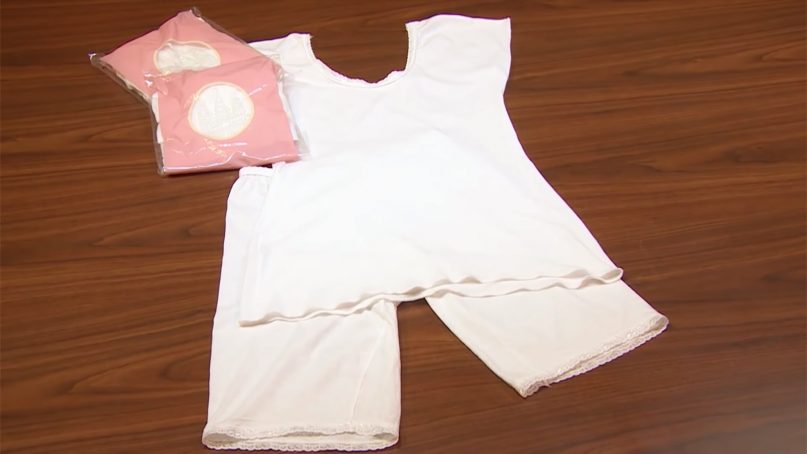(RNS) — A couple of weeks ago, around the time of The Church of Jesus Christ of Latter-day Saints’ General Conference, I began seeing images of what purported to be a package of men’s LDS temple garment shirts—without sleeves. A new tank top garment for men?
I wasn’t just skeptical, having been burned by sleeveless rumors before. I simply didn’t believe it. These kinds of rumors circulate, particularly around conference time when the bloggernacle goes a bit wild with unsubstantiated, if delicious, bits of gossip. (Another recent entry: The church will drop coffee from the Word of Wisdom and brand its own particular cuppa joe as a Cuppa Joseph. Not terribly persuasive.)
But score one for the internet rumor mill: According to a news story in The Salt Lake Tribune, both men’s and women’s garments are changing to accommodate more modern clothing styles.
No word yet on when they will become available globally, though it sounds like there will be something of a wait.
For the uninitiated, temple garments are the sacred underclothing that adult Latter-day Saints (Mormons) who have been endowed in the temple commit to wearing for the rest of their lives. For outsiders, they are a source of voyeuristic fascination. (Move along, folks. There’s really not much to see here.) For insiders, they provide a mix of devotion, pride and, for some, frustration. Many members, women in particular, have complained that garments fit awkwardly under clothes and that the fabrics don’t breathe particularly well.
In recent years, the church has gamely adjusted the garment with these complaints in mind. In 2018, women’s garments changed so that the sacred markings were silk-screened, not raised, making them less visible under outer clothing. Scratchy tags and tightly constricting arm holes gave way to stretch cotton with just the right hint of spandex. In 2021, the church ditched the itchy lace hems from women’s garments as well.

An older temple garment option for LDS females. (Video screen grab)
Perhaps as importantly, in 2019 the church handbook clarified the whole “over or under your other underwear?” question, saying it was “a matter of personal preference.” (As background: some people from previous generations had been taught that garments had to be worn next to the skin; if you wore a bra, for example, it had to go on over the garment. Many people, over many years, found that awkward and uncomfortable.)
Not to be outdone, the church also tweaked men’s garments, adding the same cotton stretch fabric that women got and shortening the sleeves. In 2022, it offered boxers for the bottoms and lowered the neckline of the tops to fit under a conventional T-shirt.
And now it’s bowing to the most-requested change I hear women mention: sleeveless garment tops. This has been the holy grail of garments, one that many people believed the church would never agree to. Over the last few decades, the church has drawn a line in the sand regarding women’s shoulders. Bare shoulders —“porn shoulders,” as some put it — were forbidden in the 1965 “For the Strength of Youth” pamphlet, and this counsel was largely continued in the subsequent editions, with the 1990 version forbidding “off-the-shoulder” attire.
More than a decade ago, the church’s anti-shoulder crusade reached a perfectly ludicrous point when it began applying its standards to perfectly innocent groups. A 2011 church magazine article, based on a true story, reported that a 4-year-old was instructed to wear a T-shirt under a sleeveless dress in order to make it more modest. In another dust-up, a church magazine actually doctored a rendition of a historic religious work of art so that the angels in the painting who had dared to show their bare angelic shoulders — the hussies—now sported modest, LDS-approved sleeves.
I hope we are past our “porn shoulder” phase. With this change to women’s garments, it would certainly seem so, because the church has to know that women will take advantage of this change and let their shoulders feel the kiss of the sun.
In fact, I suspect this decision may have been made in hopes that young people who have dropped off with their garment-wearing habits may be accommodated back into compliance. In April, when the focus was on young women and garments, I wrote that in the most recent data from the Next Mormons Survey 2, the problem wasn’t with young women, but with young people. Or rather, with anyone younger than a baby boomer.
Overall, nearly 55% of endowed members said they were wearing their garments as they took the survey, with another smattering reporting they had worn garments the day before, or at least in the past week. Altogether, 73% of current members who were supposed to be wearing garments said they had done so within the week, at least.

Just over half of respondents reported that they were wearing their garments at the time of the survey. (Source: The Next Mormons Survey 2022-23)
But as you can see in the chart below, there’s a large generation gap. The oldest U.S. Latter-day Saints appear to have no trouble wearing the garments — more than 8 in 10 who had been endowed and were therefore under an obligation to wear garments said they were wearing them the day they took the survey.
That wasn’t the case for any other generation, though. In fact, compliance for them was half of what it was for the oldest members.

For the oldest U.S. Latter-day Saints, daily wearing of the temple garment appears to be routine. For middle-aged and younger members, the practice is more haphazard among both women and men. (Source: The Next Mormons Survey 2022-23)
It’s important to recognize that the NMS2 was fielded in an odd period of church history for garment expectations. The church removed language in 2019 about wearing garments “day and night” from the temple recommend process, then restored that language earlier this year. While we’re now back to the expectation that members are supposed to wear their garments 24/7, it was not necessarily the case when the survey was fielded. Younger members’ lower-than-expected compliance may stem from their taking the removal of “day and night” as permission not to wear the garments day and night.
I expect that the one-two combo the church has given this year will increase compliance on the part of many younger members. If the “stick” is the return of the “day and night” language, which connects a failure to keep your garments on all the time with possibly flunking a temple recommend interview, the “carrot” is that the church has proved willing — multiple times in recent years — to make the garment itself more palatable.
Will it be enough, I wonder?
Related content:
Hallelujah! Mormon women’s garments just got a lot better (2018)
100 years of Mormon temple garments
It’s not just young women who have a problem with Mormon temple garments. It’s young adults, period.




